What You Need to Know About Chainsaw Chain Brakes
- February 9, 2024
- 0 comment
Chainsaws are powerful tools essential for various cutting tasks, from forestry work to home yard maintenance. However, their power comes with significant safety risks, one of which is kickback. This is where the chainsaw’s chain brake, a critical safety feature, comes into play. Understanding how to properly handle and maintain the chain brake can prevent injuries and ensure the longevity of your chainsaw. Here’s what you need to know about chainsaw chain brakes.
Importance of Releasing the Chain Brake
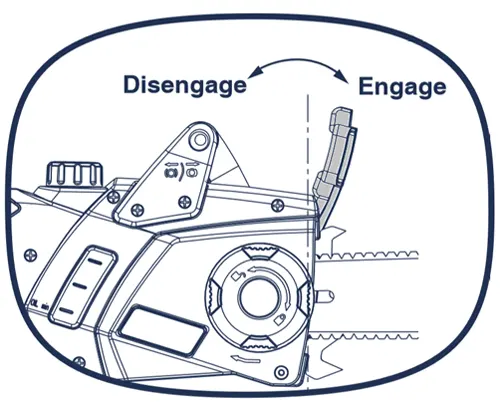
When you receive a new chainsaw, the chain brake is engaged. This is a safety measure to keep the chain from moving during shipping, preventing any damage or accidents. Before you attempt to install the bar and chain, it’s crucial to release the chain brake. Failing to do so can make it impossible to properly fit the bar or, worse, damage the chainsaw upon attempting to use it.
Chain Brake Basics
The chain brake is a key safety feature designed to stop the chain from moving around the chainsaw’s bar. You can manually activate it by pushing the brake handle forward or rely on its automatic activation during sudden movements, like kickback. To allow the chain to move freely again, simply pull the brake handle toward you, disengaging the brake.
How It Works
The chain brake’s main role is to enhance your safety by preventing kickback-related injuries. Kickback happens when the chain encounters an obstruction during cutting, causing the chainsaw to move rapidly backward towards the operator. The chain brake acts instantly in such scenarios, significantly reducing injury risks.
Handling the Chain Brake
Before Maintenance
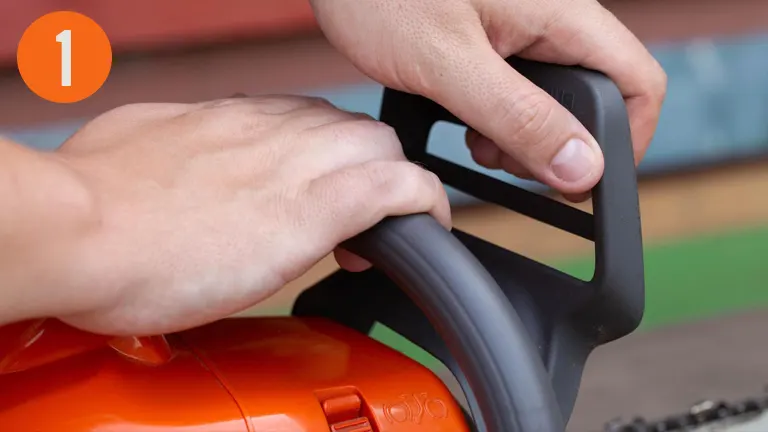
Always ensure the chain brake is disengaged before removing the chainsaw’s cover for maintenance. If the cover is removed while the brake is engaged, the band will be too tight to reassemble properly. This can lead to a situation where the cover won’t fit back on, or the brake won’t function correctly.
If a Mistake Happens
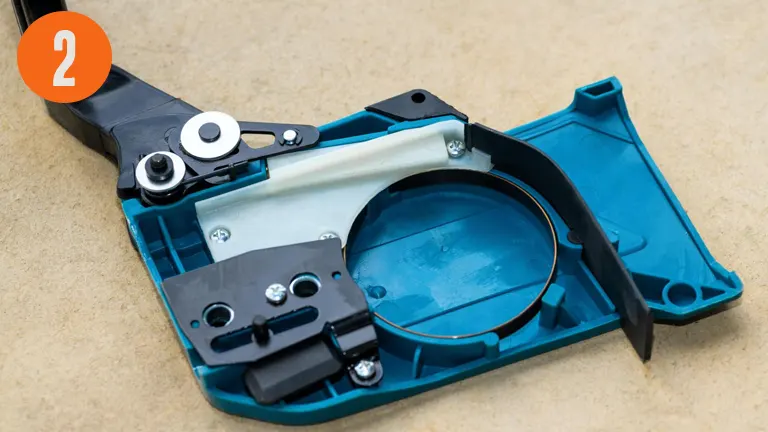
Should you accidentally remove the cover with the brake engaged, it’s unlikely you’ll be able to reset the brake yourself. This situation requires either ordering a new cover with an integrated brake or visiting a professional, such as a Husqvarna dealer, for repair.
Safety First
The chain brake is a vital safety feature designed to protect you from kickback injuries. Kickback occurs when the chain catches on something without cutting through it, causing the chainsaw to jerk back towards the operator. By stopping the chain instantly, the brake minimizes the risk of injury.
Technical Insights: Understanding Chain Brake Mechanics
The chain brake on a chainsaw is a critical safety feature designed to stop the chain’s movement almost instantaneously during a kickback scenario. Kickback occurs when the saw’s bar nose, or the tip, contacts an object, causing the chainsaw to jerk upwards and back towards the operator. The mechanics of the chain brake involve a combination of physical design and kinetic energy.
When a chainsaw experiences sudden upward movement, the inertia of the kickback activates the brake. This is due to an inertial mechanism within the chainsaw that responds to rapid movement. Essentially, the brake system consists of a weighted mechanism that, upon detecting a sudden acceleration (like during kickback), forces the brake band around the clutch drum, stopping the chain from moving.
The manual activation of the chain brake involves the operator’s hand pushing the safety lever or guard forward. This manual operation is straightforward and relies on the physical movement of the lever to engage the brake band.
Conclusion
Understanding and properly managing your chainsaw’s chain brake is not just about maintaining your equipment; it’s about ensuring your safety and that of those around you. Always release the chain brake before installing or removing the bar and chain, and ensure it’s functioning correctly before use. Remember, safety should always be your top priority when handling powerful tools like chainsaws.
Related Articles:
- Can a Chainsaw Chain Be Put on Backwards? How to Fix
- How To Switch From Winter Mode To Summer Mode: STIHL Hidden Feature
- How To Get A Chainsaw Unstuck? Expert Tips for a Quick Solution
- How To Use A Chainsaw Depth Gauge
- How To Shorten a Chainsaw Chain Without Using Spinner and Breaker
- Can You Use a Chainsaw in the Rain?
FAQs
- Can a chainsaw still function properly without a chain brake?
While a chainsaw can technically operate without a chain brake, doing so significantly increases the risk of injury. The chain brake is a crucial safety feature designed to stop the chain in the event of kickback, protecting the operator from potential harm. - How often should I test the chain brake on my chainsaw?
It’s recommended to test the chain brake before each use of the chainsaw. A quick test can ensure that the brake is engaging and disengaging properly, which is essential for safe operation. - What’s the difference between manual and inertia-activated chain brakes?
Manual chain brakes require the operator to physically engage the brake, typically by pushing forward a hand guard. Inertia-activated brakes, on the other hand, automatically engage when a sudden upward force is detected, such as during kickback, offering an additional layer of safety. - Why does my chain brake engage unexpectedly while I’m cutting?
If your chain brake engages unexpectedly, it could be due to excessive vibration or an overly sensitive inertia mechanism. However, it’s also important to ensure that you’re not accidentally applying pressure to the brake activation mechanism during use. - Can I adjust the sensitivity of the inertia-activated chain brake?
The sensitivity of the inertia-activated chain brake is generally set by the manufacturer and is not adjustable. This setting is carefully calibrated to balance safety with usability, ensuring the brake engages during genuine kickback scenarios without being triggered by normal chainsaw vibrations. - How do I know if the chain brake needs to be replaced or repaired?
Signs that your chain brake may need repair or replacement include difficulty engaging or disengaging the brake, the chain not stopping immediately when the brake is engaged, or visible damage to the brake mechanism. If you suspect an issue, consult a professional for a thorough inspection. - Is it possible to retrofit an older chainsaw with a chain brake?
Retrofitting an older chainsaw with a chain brake may be possible, depending on the model and manufacturer. However, it’s often not cost-effective or recommended due to compatibility and safety concerns. It’s usually better to invest in a newer chainsaw model that includes modern safety features, including a chain brake. - How long does a chain brake last before it needs replacement?
The lifespan of a chain brake can vary widely based on the chainsaw’s make, model, and frequency of use, as well as how well it’s maintained. With proper care and regular maintenance, a chain brake can last for the life of the chainsaw. However, components may wear out and require replacement or repair over time. - Can engaging the chain brake damage my chainsaw?
Engaging the chain brake should not damage your chainsaw if it’s functioning correctly. It’s designed to be a safety feature that can be used frequently without adverse effects. However, forcibly engaging or disengaging the brake, or operating the chainsaw with a malfunctioning brake, can cause damage. - What should I do if my chainsaw’s chain brake malfunctions while I’m cutting?
If the chain brake malfunctions while cutting, stop the chainsaw immediately and safely turn off the engine. Do not attempt to continue using the saw until the brake has been inspected and repaired by a professional. Continuing to use a chainsaw with a malfunctioning chain brake significantly increases the risk of injury.
We hope this guide has shed some light on the vital role of chainsaw chain brakes for your safety and chainsaw maintenance. But we know there’s always more to learn and share! Have you had experiences with chain brake maintenance or safety practices you’d like to tell us about? Or perhaps you have a question we didn’t cover? Drop your thoughts, stories, and questions in the comments below. Sharing knowledge helps us all stay safe and make the most of our tools. Don’t forget to share this article with fellow chainsaw enthusiasts – let’s spread the word on safe chainsaw practices together!

David Murray
Forestry AuthorI'm David Murry, a forestry equipment specialist with a focus on chainsaw operation. With over 13 years of experience, I've honed my skills in operating and maintaining a wide range of machinery, from chainsaws to log splitters. My passion for the outdoors and commitment to sustainable forestry drive my work, which emphasizes safety, efficiency, and staying updated with industry advancements. Additionally, I'm dedicated to sharing my expertise and promoting environmental awareness within the forestry community.


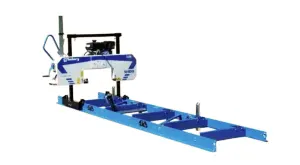
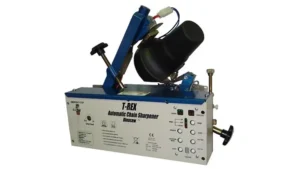

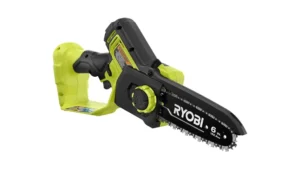
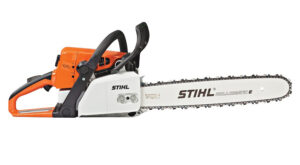

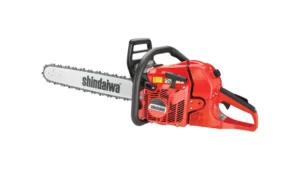
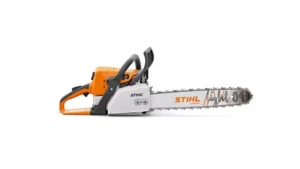
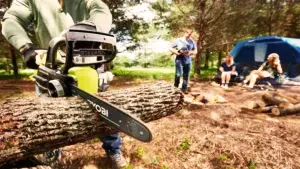
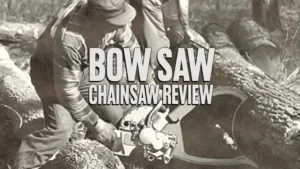
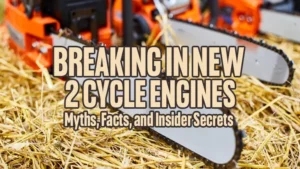
Leave your comment